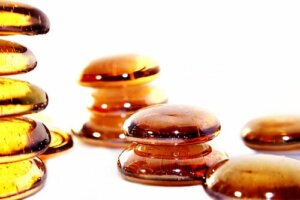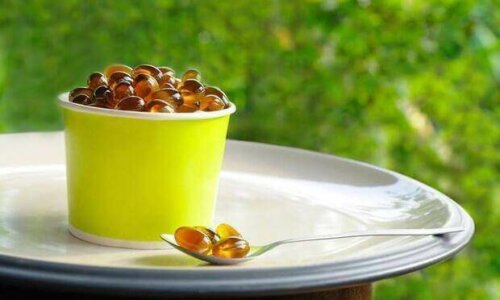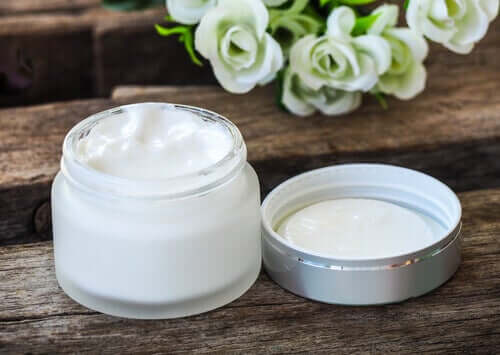Lecithin: What Is It and What's It For?


Written and verified by the nutritionist Anna Vilarrasa
Lecithin is a type of fat found in some body tissues and some plants. Chemically, it’s composed of phospholipids with phosphoric acid, choline, and glycerol, plus one or two fatty acids.
Although its name might make you think of food supplements, lecithin is a natural substance. It’s part of our tissues, tissues of other animals, and some plants. In fact, it’s a substance that we regularly produce as a result of normal digestive processes.
Lecithin was first isolated in 1850 from egg yolk. Interestingly, its name derives from the Greek term for egg: lekhitos. However, you can get it from many sources, among which the following stand out:
- Soy
- Rapeseed
- Cotton
- Sunflower seeds
- Egg
- Other animal fats
Main uses of lecithin
Lecithin has many uses in a wide variety of fields. It’s used in the food and pharmaceutical industries to make food and cosmetics. You can also take it as a supplement or use it at home to cook homemade pastries and other dishes.
Lecithin as a food supplement

One of the most widespread uses of lecithin is as a food supplement. In this case, the most common option usually comes from soy, which you can find in the form of granules or oil capsules. It’s also made from sunflower seeds or egg yolk.
Lecithin has a nutritional composition and a series of characteristics that give it numerous benefits for our body. Below you can find a list of some of them:
- One of the best-known applications and the one for which people most commonly use lecithin supplements is controlling blood cholesterol: lecithin can lower LDL cholesterol levels and increase HDL cholesterol levels.
- Digestive aid in people with ulcerative colitis. Being rich in phosphatidylcholine, it nourishes the mucous layer of the intestine. Researchers have observed improvements in the digestive processes of patients, who often have delicate intestinal mucosa.
- During lactation, lecithin can be used to prevent recurring breast duct problems, but not to treat them. The Canadian Foundation for Breastfeeding recommends it. Because of it, the milk loses some viscosity, making it less likely for the ducts to clog.
- It improves cognitive functions thanks to choline, which plays an important role in brain development. It can help improve memory.
- Possible benefits during menopause. This comes from a recent study published in the Nutrition Journal. It showed a reduction in fatigue and an increase in energy in a group of women during menopause. However, we need more research to verify these claims.
Learn more: How To Take Care of Yourself During Menopause
The use of lecithin as a food ingredient
Lecithins, regardless of their origin, have emulsifying properties. This means that they’re able to join two liquids that wouldn’t mix well, for example, oil and water. As a result, processed food products have a smooth and homogeneous appearance.
It’s common to find emulsifiers in products such as the following:
- Baked goods such as cakes, pastries, or bread – to keep them from drying out or turning rancid quickly. They also extend the shelf life and give these products a softer and more tender texture.
- Ice creams: they melt more slowly and have a smoother texture.
- Processed cheeses: allows the liquid part they add, generally water, to link well with the fatty part.
The European Union approves it as a food additive according to regulation EC 1333/2008. In the ingredient lists you can find it with the number E322.
Discover: How Do Food Additives Affect Your Body?
Beneficial for the skin
The emulsifying property of lecithins is also useful in the cosmetic industry. Thanks to this, it’s usually an ingredient in many creams. It allows manufacturers to achieve a smooth and homogeneous texture.
Furthermore, lecithin is rich in antioxidants, phosphorous, and vitamins E and A. Therefore, it’s good for keeping the skin hydrated and flexible. It can restore skin hydration and leave it smooth, reducing flaking, and providing flexibility.

Lecithin risks and contraindications
The Food and Drug Administration (FDA) and the European Food Safety Agency (EFSA) consider lecithin to be a safe ingredient or additive, both in food and in cosmetic products. Furthermore, they authorize its use without establishing maximum amounts.
The main risks of lecithins are for people with an allergy to eggs or soy. If you’re going to take lecithin supplements, you should find out where they come from. Likewise, you should read the labels of all manufactured products because, as we’ve seen, it’s an ingredient in many of them.
As a supplement, it seems to have no other risks or contraindications if you respect the indicated doses. Although we always recommend you get your nutrients from food and consult a specialist before taking any supplement. Especially if you have an illness or are taking medication.
Lecithin is not just a supplement for cholesterol
Although this is perhaps one of its best-known properties, when you take it as a supplement it can help you in many other functions and situations.
In addition, it stands out for its high capacity to emulsify aqueous and oily substances, giving rise to more homogeneous and smooth products. Thanks to this, it’s a very common ingredient, both in food and in cosmetics.
All cited sources were thoroughly reviewed by our team to ensure their quality, reliability, currency, and validity. The bibliography of this article was considered reliable and of academic or scientific accuracy.
- Bethseda. Drugs and Lactation Database (LactMed). National Library of Medicine. 2006.
- Coreyann P, t al. The relation of dietary choline to cognitive performance and white-matter hyperintensity in the Framingham Offspring Cohort. American Journal of Clinical Nutrition. Diciembre 2011. 94(6):1584-1591.
- EFSA Panel on Additives and Products or Substances used in Animal Feed (FEEDAP).Safety and efficacy of lecithins for all animal species. EFSA Journal. Agosto 2016.
- Hirose A, et al. Effect of soy lecithin on fatigue and menopausal symptoms in middle-aged women: a randomized, double-blind, placebo-controlled study. Nutritional Journal. Enero 2018. 17:4.
- Mortensen A, et al. Re‐evaluation of lecithins (E 322) as a food additive. EFSA Journal. Abril 2017.
- Reglamento (CE) n o 1333/2008 del Parlamento Europeo y del Consejo, de 16 de diciembre de 2008 , sobre aditivos alimentarios (Texto pertinente a efectos del EEE).
- Stremmel W, et al. Phosphatidylcholine (lecithin) and the mucus layer: Evidence of therapeutic efficacy in ulcerative colitis?. Digestive Diseases. 2010. 28(3):490-6.
This text is provided for informational purposes only and does not replace consultation with a professional. If in doubt, consult your specialist.








